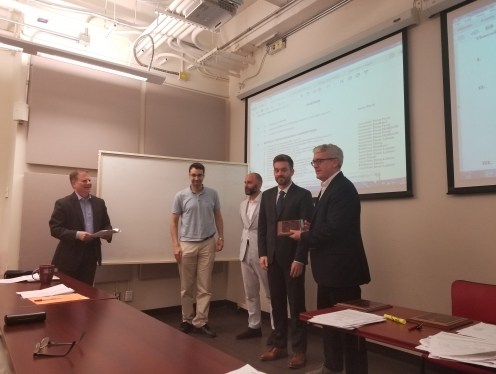Winners of the 2016-2017 William and Rhea Seath Awards Competition

William Lepry, PhD student, Professor Showan Nazhat, both Materials Engineering and Professor Faleh Tamimi (Faculty of Dentistry), for their “Remineralizing Toothpaste for Treatment of Tooth Hypersensitivity” project.
Executive summary:
It is estimated that more than half of the adult population suffer from dentine hypersensitivity; a common clinical condition that results in sharp bouts of pain generating from the mouth when teeth are exposed to external stimuli. Treatment methods include desensitizing agents in mouthwashes or chewing gums, but more recently there has been a drive towards the addition of mineralizing agents, such as bioactive glass, in toothpastes. However, the slow dissolution rate of the current glass formulations is far from ideal for dental applications, often requiring days for dissolution. At McGill, we have developed sol-gel derived borate glasses that have demonstrated remarkable rates of conversion to the mineral present in dentine (and bone); hydroxycarbonated apatite. In this application, we intend to exploit this mineralizing capacity by combining the novel glass formulation with toothpaste, to provide rapid dentine hypersensitivity relief. This award will prove vital in the progression of this technology by providing critical funds to carry out in vitro testing using human dentin models.

Professor Marta Cerruti, Materials Engineering, and her team Dr.Simon Tran (Dentistry, not present), Dr. Faleh Tamimi (Dentistry), Dr. Reza Farivar (Medicine, not present), Dr. Monzur Murshed (Dentistry, not present) for their “Polymer Coating Technology for Biomedical Applications” project.
Executive summary:
Synthetic polymeric materials are used in cell culturing and tissue engineering as platforms to enhance cell attachment, proliferation and activity, and to promote healing of injured or missing tissues. Despite being biocompatible, most synthetic polymers do not allow easy integration with cells or tissues. Thus, the surface of a polymer needs to be modified prior to any biomedical application. Current technologies result in layers that are unstable, inhomogeneous, and often degrade the polymer, in addition to being expensive and not applicable on complex geometries. We have developed a simple technology to modify polymer surfaces to promote cell adhesion and improve in-vivo performance. With the WRSA funds, we will be able to move on to commercialization.

Professor Subhasis Ghoshal (not present) and Dr. Sourjya Bhattacharjee, post-doctoral fellow, both Civil Engineering and Applied Mechanics, for their “Scale Up of Novel Biphasic Treatment Process for the Treatment of Chlorinated Solvents with Reactive Iron Nanoparticles” project.
Executive summary:
Extensive industrial use and improper disposal in the past have resulted in the widespread contamination of groundwater aquifers and soils with neurotoxic, carcinogenic chlorinated solvents such as tetrachloroethylene (PCE) and trichloroethylene (TCE). A significant fraction of the TCE and PCE are present as non-aqueous phase liquids (NAPLs) in contaminated aquifers because of their slow solubilization, leading to persistent and extensive contamination. We have developed a novel, cost effective, nanotechnology-based non-aqueous phase treatment process that rapidly transforms PCE and TCE into non-toxic gases, ethene and ethane, and chloride ions, which can be recovered and reused. The limited amounts of reagents required and the generation of commercially relevant end products make this a lower environmental footprint system than existing alternatives. Through this award, we propose to scale up and demonstrate the successful treatment of PCE and TCE in a 20 L pilot scale reactor with maximized material recycle and recovery.
